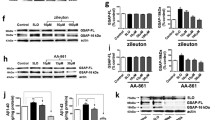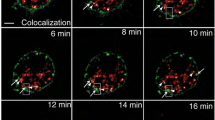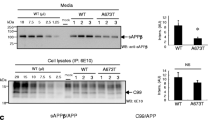Abstract
The β-amyloid peptide is generated by the proteolysis of the amyloid precursor protein (APP) by the action of β- and γ-secretase. The mechanisms underlying this process are poorly understood. Using a cell-based reporter gene assay we analysed the possible signals and pathways that could be involved in APP cleavage. We used the stable cell line HeLa AG that expresses the human APP695 fused with the yeast transcription factor Gal4. This fusion protein is normally translocated into the plasma membrane and after APP-Gal4 cleavage, the AICD-Gal4 fragment released can activate the transcription of a luciferase reporter gene. Through this reporter system, we demonstrated that Ras GTPase, but not Ral and Rap, could promote APP-Gal4 cleavage. In addition HeLa AG cells stimulated with EGF or PDGF or overexpressing EGFR exhibit increased APP proteolysis in a Ras-dependent way. This process is also dependent on γ-secretase activity, being abolished by the γ-secretase inhibitor DAPT.




Similar content being viewed by others

References
Fraser PE, Yang DS, Yu G et al (2000) Presenilin structure, function and role in Alzheimer disease. Biochim Biophys Acta 1502:1–15
Orlacchio A, St George-Hyslop PH, Sorbi S (2000) The amyloid precursor protein, presenilins and Alzheimer’s disease. Rec Res Dev Neurochem 3:205–214
Annaert W, De Strooper B (2002) A cell biological perspective on Alzheimer’s disease. Annu Rev Cell Dev Biol 18:25–51
Abbenante G, Kovacs DM, Leung DL et al (2000) Inhibitors of β-Amyloid formation based on the β-secretase cleavage site. Biochem Biophys Res Comm 268:133–135
Selkoe DJ, Yamazaki T, Citron M et al (1996) The role of APP processing and trafficking pathways in the formation of amyloid beta-protein. Ann N Y Acad Sci 777:57–64
Kamal A, Almenar-Queralt A, LeBlanc JF et al (2001) Kinesin-mediated axonal transport of a membrane compartment containing beta-secretase and presenilin-1 requires APP. Nature 414:643–648
Fiore F, Zambrano N, Minopoli G et al (1995) The region of the Fe65 protein homologous to the phosphotyrosine interaction/phosphotyrosine binding domain of Shc bind the intracellular domain of the Alzheimer’s amyloid precursor protein. J Biol Chem 270:30853–30856
Zambrano N, Buxbaum JD, Minopoli G et al (1997) Interaction of the phosphotyrosine interaction/phosphotyrosine binding related domains of Fe65 with wild type and mutant Alzheimer’s beta-amyloid precursor proteins. J Biol Chem 272:6399–6405
Russo C, Dolcini V, Salis S et al (2002) Signal transduction through tyrosine-phosphorylated carboxy-terminal fragments via an enhanced interaction with Shc/Grb2 adaptor proteins in reactive astrocytes of Alzheimer’s disease brain. J Biol Chem 277:35282–35288
Tarr PE, Roncarati R, Pelicci PG et al (2002) Tyrosine phosphorylation of the beta-amyloid precursor protein cytoplasmatic tail promotes interaction with Shc. J Biol Chem 277:16798–19804
Matsuda ST, Yasukawa T, Homma Y et al (2001) c-Jun N-terminal kinase (JNK)-interacting protein-1b/islet-brain-1 scaffolds Alzheimer’s amyloid precursor protein with JNK. J Neurosci 21:6597–6607
Minopoli G, De Candia P, Bonetti A et al (2001) The beta-amyloid precursor protein functions as a cytosolic anchoring site that prevents Fe65 nuclear translocation. J Biol Chem 276:6545–6550
Cao X, Sudhof TC (2001) A transcriptionally active complex of APP with Fe65 and histone acetyltransferase Tip60. Science 293:115–120
Zambrano N, Minopoli G, De Candia P et al (1998) The Fe65 adaptor protein interacts through its PID1 domain with the transcriptional factor CP2/LSF/LBP1. J Biol Chem 273:20128–20133
Gianni D, Zambrano N, Bimonte M et al (2003) Platelet-derived growth factor induces the β-γ-secretase-mediated cleavage of Alzheimer’s amyloid precursor protein through a Src-Rac-dependent pathway. J Biol Chem 278:9290–9297
Wang PL, Niidome T, Akaike A et al (2009) Rac1 inhibition negatively regulates transcriptional activity of the Amyloid precursor protein gene. J Neurosci Res 87:2105–2114
Connor B, Beilharz EJ, Williams C et al (1997) Insulin-like growth factor-I (IGF-I) immunoreactivity in Alzheimer’s disease temporal cortex and Hippocampus. Mol Brain Res 49:283–290
Fahnestock M, Scott SA, Jett N et al (1996) Nerve Growth Factor mRNA and protein level measured in the same tisuue from normal and Alzheimer’s disease parietal cortex. Brain Res Mol Brain Res 42:175–178
Fenton H, Finch PW, Rubin JS et al (1998) Hepatocyte growth factor (HGF/SF) in Alzheimer’s disease. Brain Res 776:262–270
Cosgaya JM, Latasa MJ, Pascual A (1996) Nerve growth factor and ras regulate beta-amyloid precursor protein gene expression in PC12 cells. J Neurochem 67:98–104
Sadot E, Jaaro H, Seger R et al (1998) Ras-signalling pathways: positive and negative regulators of tau expression in PC12 cells. J Neurochem 70:428–431
Pei JJ, Braak H, An LW et al (2002) Up-regulation of mitogen activated protein kinases ERK1/2 and MEK1/2 is associated with the progression of neurofibrillary degeneration in Alzheimer’s disease. Brain Res Mol Brain Res 109:45–46
Mei M, Su B, Harrison K et al (2006) Distribution, levels and phosphorylation of Raf-1 in Alzheimer’s disease. J Neurochem 99:1377–1388
Gartner U, Holzer M, Arendt T (1999) Elevated expression of p21Ras is an early event in Alzheimer’s deisease and procedes neurofibrillary degeneration. Neurosci 91:1–5
Gartner U, Holzer M, Heumann R et al (1995) Induction of p21ras in Alzheimer pathology. Neuroreport 6:1441–1444
Emiliani C, Urbanelli L, Racanicchi L et al (2003) Up-regulation of glycohydrolases in Alzheimer’s Disease Fibroblasts correlates with Ras activation. J Biol Chem 278:38453–38460
Urbanelli L, Emiliani C, Massini C et al (2008) Cathepsin D expression is decreased in Alzheimer’s disease fibroblasts. Neurobiol Aging 29:12–22
Minopoli G, Passaro F, Aloia L et al (2007) Receptor- and Non-receptor Tyrosine kinases induce processing of the amyloid precursor protein: role of the low-density lipoprotein receptor-related protein. Neurodegener Dis 4:94–100
Roßner S, Ueberham U, Schliebs R et al (1998) p75 and TrkA receptor signaling independently regulate amyloid precursor protein mRNA expression, isoform composition, and protein secretion in PC12 cells. J Neurochem 71:757–766
Zou L, Wang Z, Shen L et al (2007) Receptor tyrosine kinases positively regulate BACE activity and amyloid-β production through enhancing BACE internalization. Cell Res 17:389–401
Ebinu JO, Yankner BA (2000) A RIP tide in neuronal signal transduction. Neuron 34:499–502
Lorents O, Suh ER, Taylor JK et al (1999) CREB-binding protein interacts with the homeodomain protein Cdx2 and enhances transcriptional activity. J Biol Chem 274:7196–7199
Zambrano N, Gianni D, Bruni P et al (2004) Fe65 is not involved in the plateled-derived growth factor-induced processing of Alzheimer’s Amyloid Precursor Protein, which activates its caspase-directed cleavage. J Biol Chem 279:16161–16169
Zippel R, Balestrini M, Lomazzi M et al (2000) Calcium and calmodulin are essential for Ras-GRF1-mediated activation of the Ras pathway by lysophosphatidic acid. Exp Cell Res 258:403–408
Rebhun JF, Chen H, Quilliam LA (2000) Identification and characterization of a new family of guanine nucleotide exchange factors for the Ras-related GTPase Ral. J Biol Chem 275:13406–13410
De Rooij J, Zwartkruis FJ, Verheijen MH et al (1998) Epac is a Rap1 guanine-nucleotide-exchange factor directly activated by cyclic AMP. Nature 396:474–477
Medema RH, Wubbolts R, Bos JL (1991) Two dominant inhibitory mutants of p21ras interfere with insuline-induced gene expression. Mol Cell Biol 11:5963–5967
Vanoni M, Bertini R, Sacco E et al (1999) Characterization and properties of Dominant-negative mutants of the Ras-specific Guanine Nucleotide Exchange Factor Cdc25 Mm. J Biol Chem 274:36656–36662
Ceriani M, Scandiuzzi C, Amigoni L et al (2007) Functional analysis of RalGPS2, a murine guanine nucleotide exchange factor for RalA GTPase. Exp Cell Res 313:2293–2307
Tanaka S, Morishita T, Hashimoto Y et al (1994) C3G, a guanine nucleotide-releasing protein expressed ubiquitously, binds to the Src homology domains of CRK and Grb2/ASH proteins. Proc Natl Acad Sci USA 91:3443–3447
Miloso M, Mazzotti M, Vass WC et al (1995) SHC and GRB-2 are costitutively by an epidermal growth factor receptor with a point mutation in the transmembrane domain. J Biol Chem 270:19557–19562
Greco A, Mariani C, Miranda C et al (1993) Characterization of the NTRK1 genomic region involved in chromosomal rearrangements generating TRK oncogenes. Genomics 18:397–400
Liu F, Arias-Vasquez A, Sleegers K et al (2007) A genomewide screen for late-onset Alzheimer disease in a genetically isolated Dutch population. Am J Hum Genet 81:17–31
Acknowledgments
This work was supported by a FAR (ex60%) grant to E.M. and by PRIN 2005 grant. We would like to thank L.A. Quilliam for providing pFLAG-CMV2-RalA and pMT2-HA-Rlf vectors; PG Traber for pRC-CMV-Gal4 vector; N. Zambrano for constitutively active Src (SrcYF) vector; R. Zippel for pc3myc-H-Ras plasmid; A. Wittinghofer for providing pCDNA3-Rap1 and pHSG-C3G -HA vectors; J.L. Bos for pRSV-rasN17 and pRSV-rasL61 constructs; L. Beguinot for pMMTV-EGFR vectors and M. Pierotti for pRC/CMV-TrkA plasmid.
Author information
Authors and Affiliations
Corresponding author
Rights and permissions
About this article
Cite this article
Amigoni, L., Ceriani, M., Belotti, F. et al. Activation of Amyloid Precursor Protein Processing by Growth Factors is Dependent on Ras GTPase Activity. Neurochem Res 36, 392–398 (2011). https://doi.org/10.1007/s11064-010-0343-8
Accepted:
Published:
Issue Date:
DOI: https://doi.org/10.1007/s11064-010-0343-8



